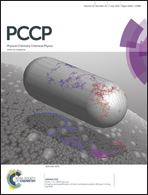Aggregation of nitroaniline in tetrahydrofuran through intriguing H-bond formation by sodium borohydride†
Abstract
The participation of sodium borohydride (NaBH4) in hydrogen bonding interactions and transient anion radical formation has been proved. Thus, the properties of NaBH4 are extended beyond the purview of its normal reducing capability and nucleophilic property. It is reported that ortho- and para-nitroanilines (NAs) form stable aggregates only in tetrahydrofuran (THF) in the presence of NaBH4 and unprecedented orange/red colorations are observed. The same recipe with nitrobenzene instead of nitroanilines (NAs) in the presence of NaBH4 evolves a transient rose red solution due to the formation of a highly fluorescent anion radical. Spectroscopic studies (UV-vis, fluorescence, RLS, Raman, NMR etc.) as well as theoretical calculations supplement the J-aggregate formation of NAs due to extensive hydrogen bonding. This is the first report where BH4− in THF has been shown to support such an aggregation process through H-bonding. It is further confirmed that stable intermolecular hydrogen bond-induced aggregation requires a geometrical match in both the nitro- and amino-functionalities attached to the phenyl ring with proper geometry. On the contrary, meta-nitroaniline remains as the odd man out and does not take part in such aggregation. Surprisingly, Au nanoparticles dismantle the J-aggregates of NA in THF. Explicit hydrogen bond formation in NA has been confirmed experimentally considering its promising applications in different fields including non-linear optics.


 Please wait while we load your content...
Please wait while we load your content...